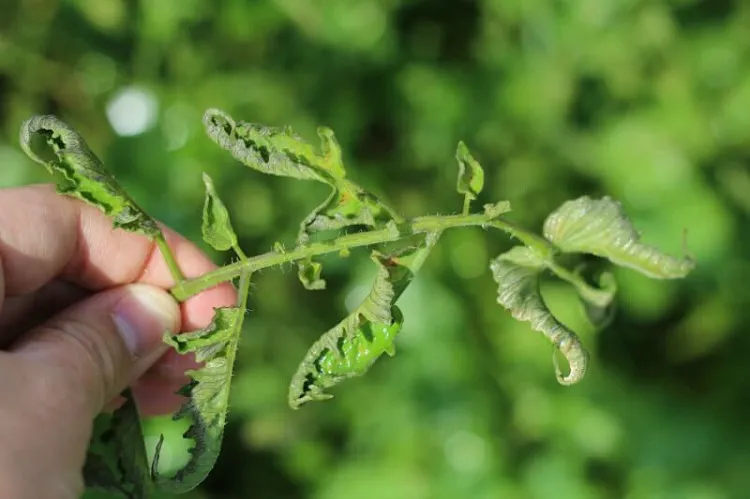So tasty vegetable, but extremely fragile, almost every problem, which appear, can cause tomato leaves curling. The condition with the changing the form of the leaves and their tips turning brown can be compared to the cry of a baby, when he is missing something, or is not accustomed to. How to help the plants, whose foliage begins to scorch? Let’s see…
Why are My Tomato Leaves Curling and Turning Brown?
This kind of changes in plant’s leaves form and color may be a response to various factors, and often are the result of unfavorable environmental conditions. Tomato is a fragile vegetable, and if something changes dramatically around it, the plant reacts immediately. There are some common causes for tomato leaf curling and browning, and the first of them is environmental stress. The possible reasons for of this reaction are numerous, this could be insufficient moisture, inconsistent watering, or excessive heat. Another factor, which can trigger that response of this tender plant, is extreme temperature fluctuations in twenty-four hours period when the nights are particularly cold and the days are hot. Additionally, when the sunlight is not enough, or alternatively, too much and intensive, this can worsen its usually more healthy look. Another unfavorable factor to consider is nutrient deficiency or imbalance in soil elements. Tomatoes require nitrogen, phosphorus, and potassium to be in good form, and their insufficient availability can manifest as deterioration of leaf condition. And lastly, not suitable pH or inadequate levels of iron, or magnesium could contribute to the problem.
How Do You Treat Leaf Curl on Tomato Plants?
The key to treating tomato leaves curling condition is addressing the underlying causes, though they may be too various. Let’s begin doing it with some of these measures:
- Maintain a balanced watering: Keep their soil consistently damp by infrequent deep watering. Though, be careful not to overwater, as it can cause root rot and subsequently increase the leaf curling. It’s good to mulch around the plants in order to retain moisture and regulate soil temperature.
- Keep an eye for adequate sunlight: Ensure your tomatoes receive at least six to eight hours of full sunlight daily. Protect them from rapid temperature fluctuations, shading the plants during hot afternoons and covering to help them bear low night temperatures.
- Improve soil conditions: Regularly determine pH level and nutrient’s content by testing the soil. Adjust the pH if necessary, when it’s not in the optimal range of 6.0 to 6.8 for these plants. Apply organic amendments or a balanced fertilizer when there is a need to enhance some nutrients.
Should I Cut Off Leaves with Leaf Curl?
Tomato leaves curling may spread on a large part of the plants’ foliage, and there are gardeners who ask should they prune the affected green parts. In most cases, it is best to leave the leaves on their places, as they still contribute to the overall health and development of the plant. They may look ill, but nevertheless, these leaves continue to function, feeding the plant with the products of photosynthesis and protecting it from intensive heat around noon.
Read also: Tomato Leaves Turning Yellow: But Why? Find Out the Underlying Reason and Revive the Plants!
How Do You Treat Leaf Curl Virus Organically?
When tomato leaves curling is caused by a virus, this is already a serious disease, and the infection may spread rapidly. Principally, there is no cure for viral infestations, but there are some useful advices to manage the symptoms, lowering the effect of the disease:
- Infected plants removal: It’s best to remove the highly affected by the Leaf curl virus plants and keep them away from the garden. Dispose them far from the other plants, with which the diseased ones may come into contact. This measure is essential to prevent further spread of the virus.
- Maintain strict hygiene: The good sanitary practices require cleaning the tools and plant’s trellises on a regular basis. This stops the spread of the virus from contaminated surfaces, to a great degree.
- Invite natural defenders: Attract beneficial insects, like ladybugs and lacewings, in your garden to feed on pests, which are able to transmit viral infections. A lot of pests can be deterred if you plant some flowers like marigolds that are useful repellents.
- Enhance plants’ health: Make an effort to improve the plants’ well-being, thus enhancing their ability to resist to infections. Care more special attention to balanced watering and nutrition, to strengthen the plants and make them more stable against viral diseases.
By this kind of care, you can help your tomato plants regain their vitality, and they will answer to your efforts with a bountiful harvest of delicious red vegetables.
Read also: DIY Calcium Fertilizer for Tomatoes: How the Home Remedy Helps with Deficiency and Blossom End Rot?





